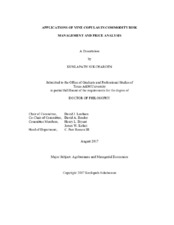| dc.contributor.advisor | Leatham, David J | |
| dc.contributor.advisor | Bessler, David A | |
| dc.creator | Sukcharoen, Kunlapath | |
| dc.date.accessioned | 2018-02-05T16:48:52Z | |
| dc.date.available | 2019-08-01T06:52:39Z | |
| dc.date.created | 2017-08 | |
| dc.date.issued | 2017-05-17 | |
| dc.date.submitted | August 2017 | |
| dc.identifier.uri | https://hdl.handle.net/1969.1/165714 | |
| dc.description.abstract | This dissertation consists of three studies that focus on applications of vine copulas, a relatively new class of multivariate copula approach, in commodity risk management and price analysis. The first study proposes a vine copula approach to estimate multiproduct hedge ratios that minimize the risk of refining margin erosion – the downside risk facing a typical oil refinery whose profit greatly depends on its refining margin or the difference between the prices of its refined products and the cost of crude oil. The out-of-sample hedging effectiveness of two popular classes of vine copula models – canonical (C-) and drawable (D-) vine copula models – are evaluated and compared with that of a widely used nonparametric method and three standard multivariate copula models. The empirical results reveal that the D-vine copula model seems to be a good and safe choice in managing the downside risk of the refinery.
The second study explores the importance of modeling heterogeneous dependence structures between different pairs of energy commodity returns with vine copulas in improving one-step-ahead density forecasts of these returns. The value of modeling heterogeneous dependence structures is measured by comparing the performance of density forecasts based on vine copulas with density forecasts based on standard copulas that assume homogeneous dependence structures. The empirical results suggest that modeling heterogeneous dependence structures using vine copulas does not help improve quality of multivariate density forecasts of energy commodity returns.
The third study applies a vine copula approach to analyze the dependence structure and tail dependence patterns among daily prices of three agricultural commodities (corn, soybean, and wheat) and two energy commodities (ethanol and crude oil) from June 2006 to June 2016. Our findings suggest that the prices of corn and crude oil are linked through the ethanol market. We also find that crude oil and agricultural commodity prices are statistically dependent during the extreme market downturns but independent during the extreme market upturns. Moreover, the results from our sub-sample analysis show that both the upper and lower tail dependence between crude oil and other commodity markets become weaker in the recent years when the ethanol market became more mature. | en |
| dc.format.mimetype | application/pdf | |
| dc.language.iso | en | |
| dc.subject | vine copulas | en |
| dc.subject | commodity risk management | en |
| dc.subject | price dependence analysis | en |
| dc.title | Applications of Vine Copulas in Commodity Risk Management and Price Analysis | en |
| dc.type | Thesis | en |
| thesis.degree.department | Agricultural Economics | en |
| thesis.degree.discipline | Agribusiness and Managerial Economics | en |
| thesis.degree.grantor | Texas A & M University | en |
| thesis.degree.name | Doctor of Philosophy | en |
| thesis.degree.level | Doctoral | en |
| dc.contributor.committeeMember | Bryant, Henry L | |
| dc.contributor.committeeMember | Kolari , James W | |
| dc.type.material | text | en |
| dc.date.updated | 2018-02-05T16:48:53Z | |
| local.embargo.terms | 2019-08-01 | |
| local.etdauthor.orcid | 0000-0002-4839-1560 | |


